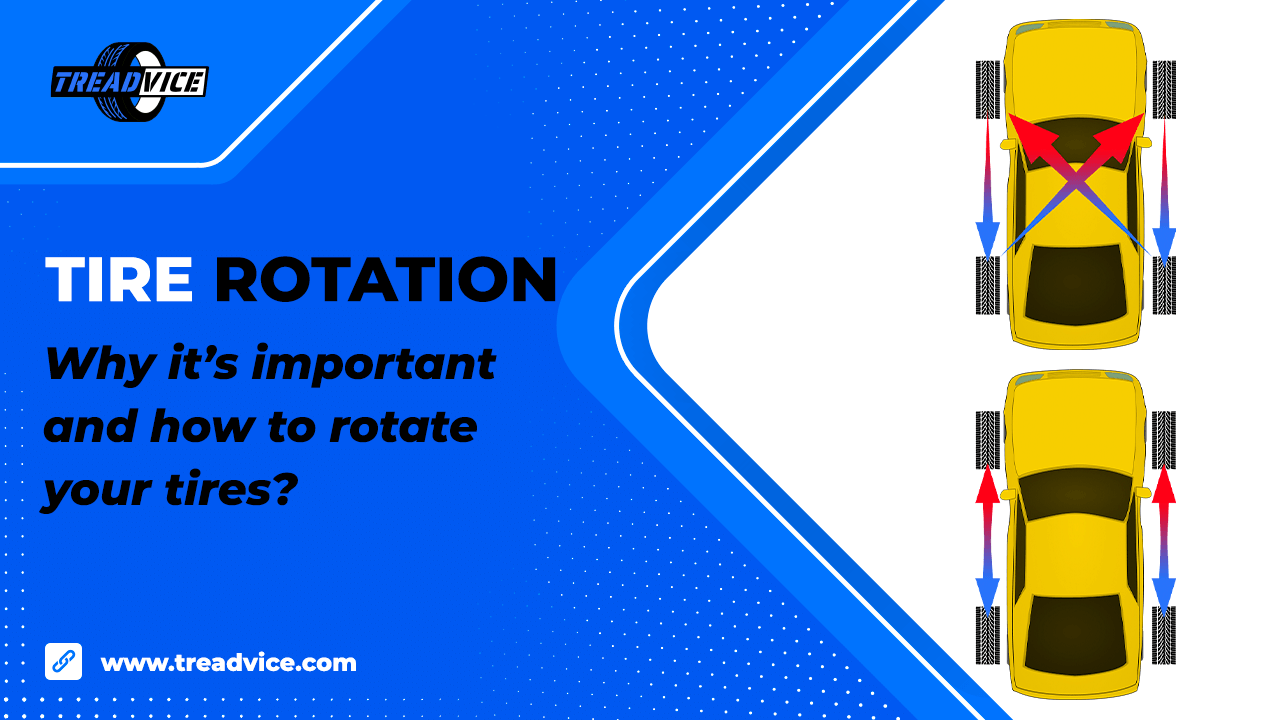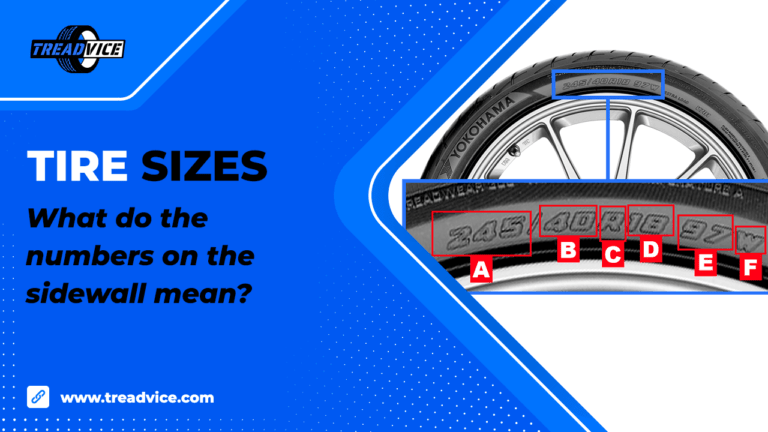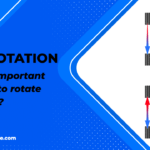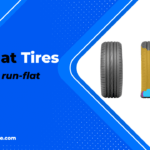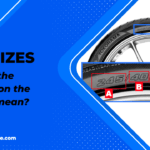Hey there, fellow car enthusiasts! Buckle up because today we’re diving into the fascinating world of tire rotation. Now, I know what you’re thinking: “Tire rotation? How exciting can that be?” Well we’re going to take this tire discussion to a whole new level, so hold on to your lug nuts. Understanding the significance of tire rotation and knowing how to perform it correctly might save you from some significant headaches (and wallet hurts) down the road, whether you’re an experienced gearhead or simply a casual driver attempting to keep those wheels spinning smoothly.
Imagine the following: You are cruising down the highway, wind in your hair (or maybe AC on full blast), feeling like the king or queen of the road. Suddenly, you notice your car starts shimmying and shaking like it’s doing the tango. Not the best dance partner, right? Well, that’s where tire rotation comes to the rescue, my friends.
In this guide, we are going to discuss why tire rotation is an important component of the car maintenance and how it could extend the life of your tires, boost the fuel efficiency, and even give you better control in those tight corners. But fear not, we won’t leave you hanging like a donut spare. We’ll also show you the ropes on how to rotate those tires like a pro.
Note: While we may have a little fun along the way, trust me, we’re dead serious about keeping you informed and helping you become a tire rotation maestro. So, let’s get rolling!
Table of Contents
What is Tire Rotation?
Tire rotation may sound like a fancy term, but fear not, it’s not rocket science! So, what exactly is tire rotation? Well, think of it as a tire shuffle party where each tire gets a chance to take a spin in a different position on your vehicle.
Tire rotation involves moving the tires from one position to another on your vehicle. This means that the front tires may swap places with the rear ones or switch sides altogether. But why go through all this tire-swapping trouble? The answer lies in the pursuit of even wear and optimal performance.
You see, each tire on your car wears down differently depending on its position. The front tires, for instance, bear the brunt of the steering and the majority of the braking forces. Meanwhile, the rear tires often have a more passive role, just happily rolling along. Over time, this uneven distribution of wear can lead to imbalanced tread depths, compromising both safety and performance.
Here’s where tire rotation swoops in to save the day. By regularly swapping the tires’ positions, you ensure that each tire gets its fair share of action. This evens out the wear across all four tires, extending their lifespan and maximizing their performance potential. It’s like sending your tires to a rejuvenating spa retreat, allowing them to relax and unwind (pun intended).
But it’s not just about pampering your tires; it’s about ensuring a safer and smoother ride for you. When your tires wear down evenly, they maintain consistent traction and grip on the road. This means better handling, improved braking efficiency, and enhanced overall stability. It’s like giving your car a set of superhero tires, ready to tackle any road conditions with ease.
So, the next time someone asks you what tire rotation is all about, you can confidently explain that it’s the art of achieving balance, harmony, and longevity for your tires. It’s the secret weapon against uneven wear and a surefire way to keep your car rolling smoothly mile after mile. Get ready to join the tire rotation revolution and let your tires groove to a symphony of even wear and peak performance.
In the next section, we’ll dive into the signs that indicate your tires are due for a rotation. So, stay tuned and let’s keep this tire-rrific journey going!
What are the Signs That Your Tires Need Rotation?
Ah, the telltale signs that it’s time to give your tires a little shuffle. Paying attention to these indicators will ensure that you rotate your tires at the right time, preventing any unnecessary wear and tear. So, let’s take a closer look at the signs that scream “Rotate me, please!”
- Uneven Tread Wear: Have you noticed that the tread on your tires is wearing unevenly? Picture this: one tire is wearing down faster on the edges, while another has a more uniform tread wear. This is a clear sign that your tires are begging for a rotation. Uneven tread wear can happen due to various factors, such as improper wheel alignment, suspension issues, or even neglecting regular tire rotations. By addressing this issue promptly, you can avoid premature tire replacement and keep your wallet happy.
- Vibration Vibes: Do you feel a noticeable vibration coming through the steering wheel or even the whole car? While it’s possible that your tires are out of balance, it could also be a sign of uneven tire wear. When the tread wear isn’t even across all four tires, it can lead to imbalanced weight distribution, causing those unpleasant vibrations. A proper tire rotation can help distribute the wear and bring back the smoothness to your ride.
- Noise Complaints: Is your car suddenly getting a bit too vocal on the road? Excessive road noise can be another sign that your tires are due for rotation. As tires wear unevenly, certain areas may become more susceptible to generating noise as they make contact with the road surface. By rotating your tires, you give each tire an opportunity to experience different positions and reduce the noise levels, making your journey more peaceful and serene.
- Tire Pressure Discrepancies: Keep an eye on your tire pressure! If you notice that one or more tires consistently have lower pressure than the rest, it could be an indication of uneven wear. As tires wear unevenly, they may lose air more rapidly in specific areas, leading to pressure imbalances. Regularly checking and adjusting tire pressure can help mitigate this issue, but don’t forget that a proper tire rotation will also contribute to maintaining optimal tire pressure.
Remember, these signs shouldn’t be ignored. They serve as your tires’ way of communicating their needs. By paying attention to them and promptly scheduling a tire rotation, you can ensure that your tires wear evenly and continue to provide optimal performance and safety on the road.
In the next section, we’ll uncover the key benefits of tire rotation. So, let’s keep the tire talk rolling, shall we?
Benefits of Tire Rotation
Tire rotation isn’t just a chore to check off your car maintenance list. Rotating your tires on a regular basis will give you a ton of benefits that will make both you and your pocketbook happy. So, let’s dive into the marvelous advantages of tire rotation, shall we?
- Extended Tire Lifespan and Cost Savings: Picture this: you’re strolling into the tire shop, ready to drop some serious cash on a brand-new set of tires. But hold on! By incorporating tire rotation into your maintenance routine, you can significantly extend the lifespan of your tires. How? Well, as we mentioned earlier, tire rotation ensures even wear across all four tires. By distributing the wear more evenly, you’re essentially spreading the love (and mileage) among your tires. This means you’ll be hitting the tire shop less frequently, saving you some hard-earned dollars in the long run.
- Improved Fuel Efficiency and Traction: Who doesn’t want better fuel efficiency? By rotating your tires regularly, you’ll experience improved gas mileage. Unevenly worn tires can create drag and resistance, forcing your car’s engine to work harder and gulp down more fuel. With properly rotated tires, your vehicle will glide effortlessly along the road, allowing for smoother, more efficient travels. Plus, let’s not forget about traction! Even tire wear enhances grip and traction, especially in challenging road conditions. So, whether you’re cruising on a rainy day or tackling a snowy slope, properly rotated tires will keep you on the road and in control.
- Enhanced Handling and Safety on the Road: Your safety is non-negotiable, and properly rotated tires play a vital role in keeping you secure on the asphalt. When your tires wear evenly, your car’s handling and maneuverability improve. You’ll notice more responsive steering, better cornering, and a smoother ride overall. Unevenly worn tires, on the other hand, can result in compromised handling, increased braking distances, and reduced stability. By embracing tire rotation, you’re prioritizing your safety and ensuring that your vehicle performs at its best, keeping you confidently in command behind the wheel.
So, my friend, tire rotation isn’t just about tire swapping for the fun of it. It extends tire life, saves you money, boosts fuel efficiency, enhances traction, and ensures your safety on the road. It’s a win-win situation that keeps your wheels spinning in top-notch condition.
In the next section, We’ll get down to business and show you how to rotate tires like an expert. Ready? Let’s get our hands dirty!
How to Rotate Tires: A Step-by-Step Guide
Finally, we got to this point! Ready to become a tire rotation expert? If so, then grab your wrenches and let’s get right in!
Step 1: Gather the necessary tools
Make sure you have all the necessary tools before starting your tire rotation quest. You’ll need a jack or a lift, a lug wrench, a torque wrench, and a set of jack stands for safety. Oh, and don’t forget a little elbow grease and a can-do attitude!
Step 2: Identify the appropriate tire rotation pattern
Different vehicles have different tire rotation patterns based on factors like drivetrain type and tire wear characteristics. Check your vehicle’s manual or consult with a trusted mechanic to determine the recommended rotation pattern. The most common patterns include: forward cross, rearward cross, X-pattern, and the side-to-side rotation. Each pattern ensures that tires change positions effectively, promoting even wear.
Forward Cross Rotation
For FWD ( front-wheel-drive ) automobiles, the Forward Cross rotation pattern is among the more popular and advised ones. In this arrangement, the rear tires are shifted diagonally to the opposing front positions while the front tires are moved straight to the back.
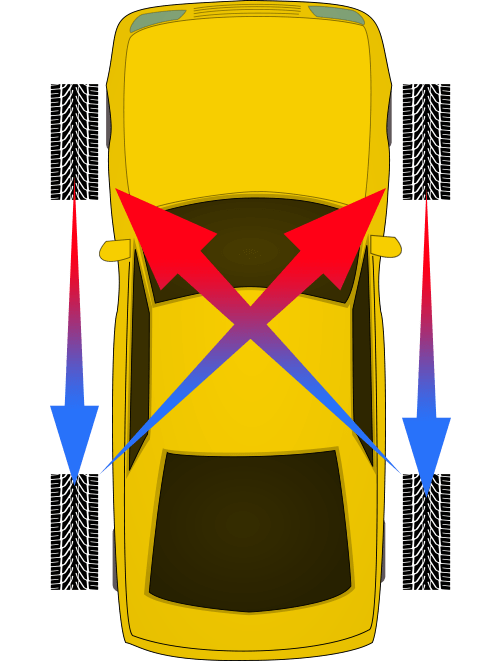
This is how it goes:
- The left front tire is moved to the left rear position.
- The right front tire is moved to the right rear position.
- The left rear tire is moved to the right front position.
- The right rear tire is moved to the left front position.
This rotation pattern helps to even out wear on the front tires, which typically experience more stress due to steering and braking, while also ensuring that the rear tires are consistently rotated.
Rearward Cross Rotation
The Rearward Cross rotation pattern is commonly used for rear-wheel-drive vehicles. It is similar to the Forward Cross rotation pattern but in the opposite direction.
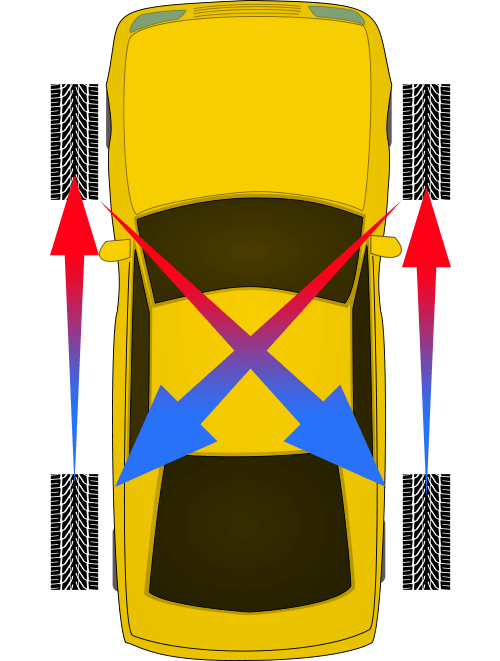
The way it works:
- The left front tire is moved to the right rear position.
- The right front tire is moved to the left rear position.
- The left rear tire is moved to the right front position.
- The right rear tire is moved to the left front position.
This rotation pattern helps equalize wear on the rear tires, which tend to experience more stress in rear-wheel-drive vehicles.
X-Pattern Rotation
The X-Pattern rotation, as the name suggests, involves creating an “X” pattern with the tire positions during rotation. This pattern is ideal mainly for the RWD (rear-wheel-drive) and some AWD( all-wheel-drive) vehicles.
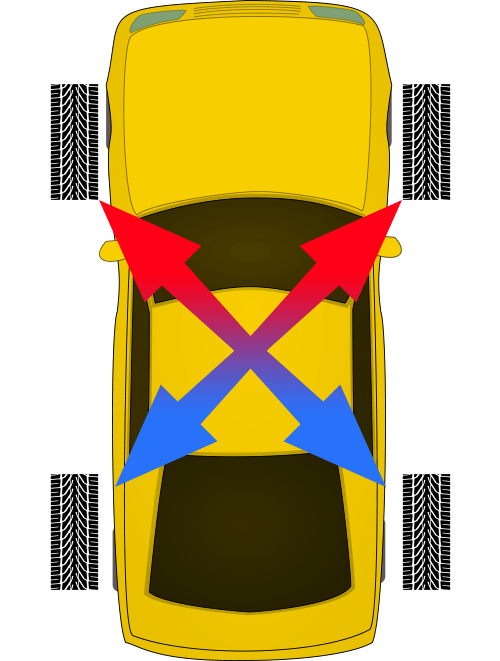
Here it is how this one works:
- The left front tire is moved to the right rear position.
- The right front tire is moved to the left rear position.
- The left rear tire is moved to the right front position.
- The right rear tire is moved to the left front position.
The X-Pattern rotation helps distribute wear evenly across all four tires and can be particularly beneficial for vehicles with different tire sizes or when there are noticeable differences in wear between front and rear tires.
Side-to-Side Rotation:
Vehicles with non-directional tires of the same size on all four wheels frequently utilize the side-to-side rotation pattern. In the case of this pattern, the tires are moved to the opposite side of the vehicle and meanwhile they remain on the same axle ( front tires remain on the front axle and rea tires remain on the rear axle ).
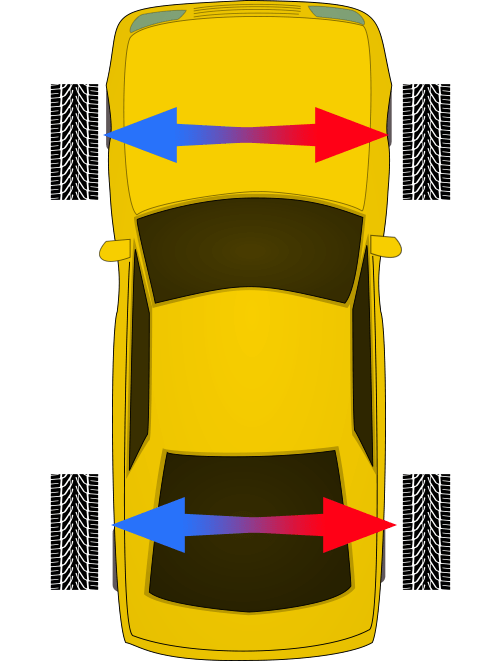
This is how it goes:
- The left front tire is moved to the left rear position.
- The right front tire is moved to the right rear position.
- The left rear tire is moved to the left front position.
- The right rear tire is moved to the right front position.
The Side-to-Side rotation pattern helps ensure even wear across all tires and is convenient when there are no significant variations in wear between the front and rear tires.
Directional Tire Rotation
Directional tires have tread patterns designed to rotate in a specific direction for optimal performance. When rotating directional tires, it’s important to maintain their original rotation direction. In this pattern, the tires are moved from one side to the other while maintaining their directional rotation.
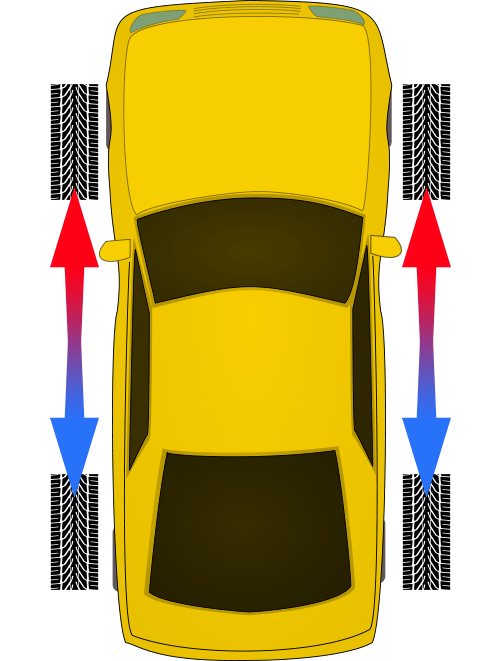
This is it:
- The left front tire is moved to the left rear position, maintaining the original rotation direction.
- The right front tire is moved to the right rear position, maintaining the original rotation direction.
- The left rear tire is moved to the left front position, maintaining the original rotation direction.
- The right rear tire is moved to the right front position, maintaining the original rotation direction.
Following the correct rotation direction is crucial for directional tires to maintain their intended performance characteristics.
Step 3: Lift the vehicle and remove the wheels
Here comes the fun part! Carefully use the jack or lift to raise the vehicle off the ground. Once elevated, secure the vehicle with jack stands for added safety. Now, it’s time to unleash your inner mechanic and remove the wheels using the lug wrench. Remember to loosen the lug nuts before lifting the vehicle completely off the ground to prevent any mishaps.
Step 4: Rotate the tires according to the recommended pattern
Referencing the rotation pattern determined in Step 2, it’s time to rotate those tires like a pro. Take each tire and move it to the appropriate position based on the selected pattern. Using the forward cross pattern as an illustration, the front left tire would move to the rear right, the front right to the rear left, the rear left to the front left, and the rear right to the front right ( so basically the rear tries remain on the same side just they move forward, and the front tires switch sides and move to the rear ).
Step 5: Reinstall the wheels and lower the vehicle
With the tires successfully rotated, it’s time to put them back on. Align each wheel with the corresponding hub and hand-tighten the lug nuts as much as possible. Once all the wheels are in place, use the torque wrench to tighten the lug nuts to the manufacturer’s recommended torque specifications. Double-check the torque on each lug nut to ensure they’re all properly tightened.
Step 6: Perform a final check and adjust tire pressure
Congratulations, you’ve completed the tire rotation process! But before you hit the road, perform a final check. Ensure all lug nuts are secure, give each tire a visual inspection for any signs of damage, and don’t forget to adjust the tire pressure according to your vehicle’s recommended levels. Properly inflated tires contribute to better fuel efficiency, handling, and tire longevity.
And voila! You’ve successfully rotated your tires like a seasoned pro. Give yourself a pat on the back, my friend, as you have just made a significant step forward in maintaining the health and performance of your wheels.
In the next section, we’ll share some pro tips to help you become a tire rotation maestro. So, stay tuned and let’s keep those tires rolling smoothly!
Pro Tips for Successful Tire Rotation
Congratulations on mastering the art of tire rotation! But wait, there is still some additional information that you might find interesting.. To become a true tire rotation maestro, here are some pro tips to keep in mind for a successful rotation every time:
How often should you rotate tires
Tire rotation frequency can vary depending on your vehicle type, drivetrain, and manufacturer recommendations. But generally speaking, it’s recommended to rotate your tires every 5,000 to 8,000 miles, or every six months, whichever comes first. However, make sure to inspect your vehicle’s manual or contact the manufacturer for the specific rotation intervals tailored to your car. Following these guidelines will ensure that your tires wear evenly and maintain optimal performance.
Importance of maintaining proper tire pressure
We can’t express this enough—maintaining proper tire pressure is key to ensuring a successful tire rotation. Before you start the rotation process, check and adjust the tire pressure to the recommended levels specified by your vehicle’s manufacturer. Properly inflated tires not only promote even wear but also enhance fuel efficiency, handling, and overall tire longevity. So, grab that trusty tire pressure gauge and keep those tires properly inflated.
Rotating tires in case of directional and staggered tire setups
If your vehicle is equipped with directional or staggered tires, there are a few additional considerations to keep in mind during the rotation process. Directional tires have a specific tread pattern designed to rotate in a particular direction. When rotating these tires, it’s crucial to maintain their original rotation direction.
In case of staggered tire setups, where the front and rear tires have different sizes, you’ll need to rotate the tires within the same axle rather than across axles (front to rear and vice versa). Following these guidelines will ensure that your directional or staggered tires continue to perform optimally.
Seek professional assistance if uncertain
If you’re unsure about the tire rotation process or have specific concerns regarding your vehicle’s tires, don’t hesitate to seek professional assistance. Experienced mechanics or tire specialists can provide expert guidance tailored to your specific vehicle and tire setup. They can help determine the appropriate rotation pattern, address any specific issues, and ensure that the rotation is performed correctly, giving you peace of mind and optimal tire performance.
By incorporating these pro tips into your tire rotation routine, you’ll elevate your maintenance game and keep your tires in top-notch condition for miles to come. Remember, proper tire rotation is a key ingredient in the recipe for optimal tire performance, even wear, and a smooth and safe driving experience.
In the next section, we’ll uncover some common tire rotation mistakes to avoid. So, buckle up and let’s steer clear of those pitfalls!
Common Tire Rotation Mistakes to Avoid
We’ve come a long way on our tire rotation journey, but let’s pause before we cross the finish line to point out some common pitfalls and errors that you shouldn’t commit. By avoiding these mistakes, you’ll ensure that your tire rotation efforts yield the desired results. So, let’s dive right in and avoid these tire rotation mishaps:
Incorrect rotation patterns and their consequences
One of the most critical mistakes in tire rotation is using the wrong rotation pattern or failing to follow the recommended pattern for your specific vehicle. Each vehicle and tire setup may have a unique rotation pattern designed to promote even wear and maximize tire lifespan. Using the wrong pattern or neglecting to follow the recommended one can lead to uneven wear, compromised handling, reduced traction, and increased risk of tire failure. Always consult your vehicle’s manual or seek professional advice to determine the appropriate rotation pattern for your specific situation.
Neglecting tire rotation altogether and potential risks
Perhaps the biggest mistake you can make is neglecting tire rotation altogether. Some drivers underestimate the importance of regular rotation, thinking it’s an optional maintenance task. However, failing to rotate your tires can result in uneven wear, reduced tread life, decreased fuel efficiency, compromised handling, and increased risks of blowouts or accidents. Tire rotation is a proactive measure that helps distribute wear and ensures all tires experience similar road conditions. Don’t let neglect be the Achilles’ heel of your tires—make tire rotation a regular part of your maintenance routine.
Ignoring tire pressure and alignment
Tire rotation is an excellent opportunity to check and address tire pressure and wheel alignment issues. However, neglecting to check and adjust tire pressure or ignoring wheel alignment concerns during the rotation process can impact tire wear and performance. Improper tire pressure can lead to uneven wear patterns, reduced fuel efficiency, and compromised handling. Likewise, misaligned wheels can cause uneven tire wear, steering drift, and potential safety hazards. Take the time to check and adjust tire pressure and consider getting a professional wheel alignment if necessary.
Not using the torque wrench
When reinstalling the wheels after rotation, it’s crucial to use a torque wrench to tighten the lug nuts to the manufacturer’s recommended specifications. Skipping this step or using improper torque can result in under or over-tightened lug nuts, leading to uneven pressure distribution, wheel imbalance, and potential wheel detachment while driving. Ensure that you have a torque wrench on hand and use it to tighten the lug nuts accurately.
Avoiding these common tire rotation mistakes will help you maximize the benefits of this essential maintenance task. By following the correct rotation pattern, prioritizing regular rotation, maintaining proper tire pressure, addressing wheel alignment concerns, and using a torque wrench, you’ll keep your tires happy, healthy, and ready to roll for miles to come.
In the next section we will answer some of the most frequently asked questions.
Tire Rotation FAQs
Keeping an eye on your tire wear is the key to determining if your vehicle requires tire rotation. Check the tires for any signs of uneven wear, such as extreme wear on the front or rear tires, wear in the tread’s center or edges, or striking difference in the tread depth. Additionally, if your vehicle’s manufacturer recommends specific rotation intervals in the owner’s manual, it’s wise to follow those guidelines.
Tire rotation can be performed both by yourself and by a professional. You can easily take on it as a DIY project if you feel comfortable doing so and if you have the required equipment and experience. However if you’re unsure of the procedure, lack the necessary tools, or have a complicated tire configuration, then it is probably better to seek advice from a qualified mechanic or tire expert. They can ensure that the rotation is done correctly and address any specific concerns related to your vehicle.
Tire rotation and tire balancing are separate maintenance tasks, but it’s a good idea to consider balancing your tires when you rotate them. Tire balancing helps distribute weight evenly across all four tires, reducing vibrations and promoting a smoother ride. If you notice vibrations or irregularities while driving, it may be an indication that your tires need balancing. Consult a professional to assess if balancing is necessary during the rotation process.
Spare tires typically don’t experience the same amount of wear as regular tires since they are often kept as backups. However, including the spare tire in the rotation process is a good practice. By rotating the spare tire into the regular rotation cycle, you’ll ensure that all tires wear evenly and maintain similar road characteristics. This also allows you to examine the condition of the spare tire regularly and make sure it is prepared for usage in an emergency.
Tire rotation alone cannot fix alignment issues. If you suspect your vehicle has alignment problems, it’s best to have the alignment checked and corrected separately by a professional. Proper alignment ensures that your tires wear evenly and your vehicle maintains optimal handling and performance. Combining regular tire rotation with periodic wheel alignment will help prolong tire life and maintain overall driving safety.
The time it takes to perform a tire rotation can vary depending on factors such as the complexity of your tire setup, the experience level of the person performing the rotation, and the availability of tools. On average, a tire rotation can be completed in about 30 minutes to one hour. However, this is just an estimate, and the actual time may differ. If you’re having your tires rotated by a professional at an auto service center, they can provide you with a more precise time frame based on their expertise and workload.
The cost of a tire rotation can also vary depending on several factors, including the location, the service provider, and any additional services included. As a general guideline, the cost for a standalone tire rotation at an auto service center typically ranges from $20 to $50. However, keep in mind that prices may vary, so it’s always a good idea to check with your local service providers for accurate pricing information. Some shops may also offer discounted or bundled services, so inquire about any package deals that include tire rotation along with other maintenance tasks.
By addressing these frequently asked questions, we hope to have shed light on some common concerns surrounding tire rotation. Remember, understanding the importance of tire rotation, following recommended guidelines, and seeking professional assistance when needed will help you keep your tires in top-notch condition.
In conclusion, tire rotation is an essential maintenance task that promotes even wear, extends tire life, enhances performance, and contributes to your safety on the road. So, embrace the rotation routine, follow the recommended patterns, and give your tires the love and attention they deserve.
Now that you’re armed with knowledge and tips for successful tire rotation, go forth and conquer the roads with confidence. Happy tire rotating!
